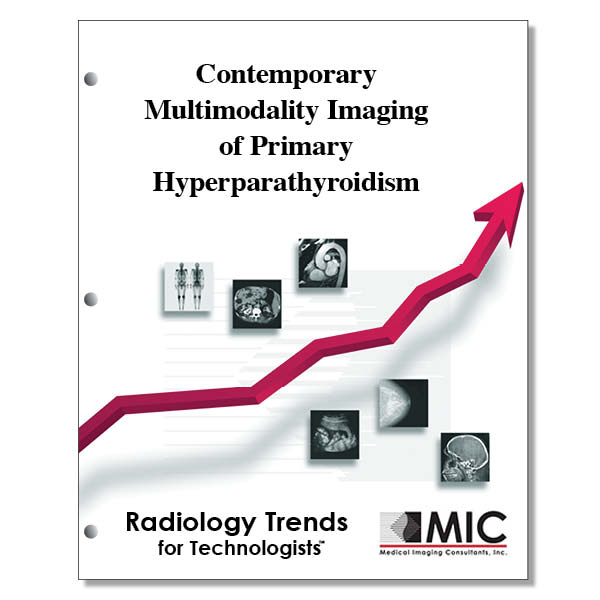

Contemporary Multimodality Imaging of Primary Hyperparathyroidism
Epidemiologic features, relevant anatomy, pathophysiology, and management of primary hyperparathyroidism are described, and the relative merits of different localization techniques are discussed.
Course ID: Q00712 Category: Radiology Trends for Technologists Modalities: CT, MRI, Nuclear Medicine, PET, Sonography2.75 |
Satisfaction Guarantee |
$29.00
- Targeted CE
- Outline
- Objectives
Targeted CE per ARRT’s Discipline, Category, and Subcategory classification:
[Note: Discipline-specific Targeted CE credits may be less than the total Category A credits approved for this course.]
Computed Tomography: 2.00
Procedures: 2.00
Neck and Chest: 2.00
Magnetic Resonance Imaging: 2.00
Procedures: 2.00
Neurological: 2.00
Nuclear Medicine Technology: 2.00
Procedures: 2.00
Endocrine and Oncology Procedures: 2.00
Registered Radiologist Assistant: 2.75
Procedures: 2.75
Musculoskeletal and Endocrine Sections: 2.75
Sonography: 2.75
Procedures: 2.75
Superficial Structures and Other Sonographic Procedures: 2.75
Outline
- Introduction
- Epidemiologic Features
- Anatomy and Physiology
- Clinical Presentation and Diagnosis
- Management
- Localization Techniques
- US Localization
- 99mTc-Sestamibi Scanning Localizaion
- Four-Dimensional CT localization
- MRI Localization
- Choline PET and PET/CT Localization
- Venous Sampling with Parathyroid Arteriography
- Persistent or Recurrent PHPT
- Conclusion
Objectives
Upon completion of this course, students will:
- list the biochemical characteristics associated with PHPT
- identify individuals at higher risk for PHPT
- understand where the majority of PHPT originate
- identify common locations for ectopic inferior parathyroid glands
- understand how PHPT is diagnosed
- identify common locations for ectopic parathyroid glands
- explain the role of medical imaging following a PHPT diagnosis
- understand the criteria for surgery in the setting of asymptomatic PHTP
- list advantages associated with minimally invasive parathyroid surgery
- identify cost-effective initial imaging recommended for PHTP cases
- explain how patient swallowing or head turning with US aids with gland localization
- list abnormal adenoma characteristics seen on US
- identify advantages and drawbacks associated with US imaging and PHPT
- understand when US-guided FNA is recommended in PHPT cases
- list factors associated with 99mTc-sestamibi uptake in overactive parathyroid glands
- understand the normal biodistribution of 99mTc-sestamibi
- understand the imaging parameters for 99mTc-sestamibi SPECT/CT imaging
- identify the benefits of SPECT/CT versus SPECT alone
- describe the different protocols used in scintigraphy for adenoma localization
- list false positives and false negatives associated with 99mTc-sestamibi imaging
- identify thyroid avid radiopharmaceuticals used in adenoma scintigraphy protocols
- identify the imaging protocol with the highest accuracy for adenoma localization
- describe the intraoperative adenoma localization protocol
- describe the 4D CT protocol
- list drawbacks associated with 4D CT
- describe the image pattern on 4D CT that differentiates thyroid from an adenoma
- understand anatomy that will show peak contrast enhancement on 4D CT
- understand the advantages of 4D CT over 99mTc-sestamibi
- describe the MRI signal intensities associated with an adenoma
- understand how MRI heterogeneous signal intensity can aid in lesion localization
- describe characteristics of contrast-enhanced multiparametric dynamic MRI and adenomas
- identify radiotracers used for parathyroid adenoma PET imaging
- understand PET imaging protocols using 11C-choline
- understand the normal biodistribution of 18F-fluorocholine
- describe the imaging differences of PET/CT compared to SPECT/CT
- understand anatomical uptake patterns associated with 11C-choline
- describe which PET radiotracer has the most favorable properties
- explain what cohort of PHPT patients should undergo venous sampling
- identify venous sampling points associated with eutopic adenomas
- identify characteristics associated parathyroid arteriography
- describe reasons contributing to persistent or recurrent PHPT
- identify imaging options when repeat surgery is considered for recurrent PHPT
- list recommendations in post parathyroidectomy patients with multigland disease
